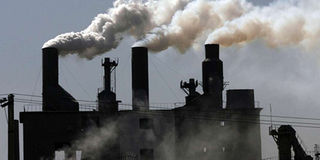How to make cash from global clean air project

Industries emit thick smoke into the air. To manage climate change through reduced emission and capture and storage of the GHGs, the United Nations came up with the Clean Development Mechanism concept where each of the 38 developed countries was given a limit as to the amount of GHG that it can emit. FILE PHOTO | NMG
What you need to know:
- There are 15 CDM targeted sectors that include energy, transport, industrial waste disposal, afforestation/reforestation and agriculture, among others.
- International acceptance of a CDM project first requires approval at the national level, consistent with the country’s domestic laws and policy priorities.
- The difference in fuel utilisation leads to reduced CO2 production from burning the fuel and this can be used to claim CERs.
- For economies of scale, small-scale farmers have to form groups and come up with a programme of activities that constitute a CDM.
Production of greenhouse gasses (GHGs) that include carbon dioxide (CO2), nitrous oxide and methane leads to global warming.
The warmer environmental temperatures in return affect rainfall and weather patterns, hence climate change. These gasses are produced through man’s activities, including agricultural production.
To manage climate change (CC) through reduced emission and or capture and storage of the GHGs, the United Nations came up with the Clean Development Mechanism (CDM) concept where each of the 38 developed countries was given a limit as to the amount of GHGs that it can emit.
In case it has to exceed that amount, it has to support a project in the developing countries that has the ability to capture and store or reduce GHGs equivalent to what it (developed country) is producing.
This trade is referred to “cap and trade”. The aim of CDM, therefore, is two-fold; reduce GHG emissions by developed countries and economic development of the developing countries.
There are 15 CDM targeted sectors that include energy, transport, industrial waste disposal, afforestation/reforestation and agriculture, among others.
Voluntary initiatives, governments, private companies, and individuals have collectively committed billions of dollars to buy emission reductions.
Despite its potential for project development, small-scale farmers have not benefited much from CDM due to limited understanding of its process and opportunities available in agriculture, plus examples that they can borrow from.
CDM process has five steps: (1) Project design, (2) Validation/registration (3) Monitoring, (4) Verification/certification and (5) Issuance of Certified Emission Reductions (CERs), which are the units of trade.
In the project design, the process starts with identification of a project with a CDM potential and then preparation of a Project Idea Note (PIN), which is further developed to a Project Design Document (PDD).
International acceptance of a CDM project first requires approval at the national level, consistent with the country’s domestic laws and policy priorities.
The country’s Designated National Authority (DNA) issues this approval and in Kenya, the National Environmental Management Authority (Nema) is the DNA. Project participants then submit the PDD to the CDM Executive Board (EB).
EMISSION REDUCTION
An example of a project idea in the transport sector is like conversion of matatus (14 seaters) to buses (64 seaters) transport system.
The bus might use slightly more fuel than a matatu in any one trip but it carries more than five times the number of people per trip.
The difference in fuel utilisation leads to reduced CO2 production from burning the fuel and this can be used to claim CERs.
Collection and archiving of all relevant data necessary for estimating or measuring emission reductions occurring within the project is referred to as monitoring and is an important tool in verification/certification of the project and issuance and confirmations of CERs worth of the project. Steps 1 and 3 are carried out by the project owner; steps 2 and 4 by Designated Operational Entities (DOEs) while step 5 by the CDM executive board. DOEs are bodies registered by the CDM executive board. One CER is corresponds to one tonne of carbon dioxide equivalent whose value can vary between $3 and $20.
All information on CDM including a list of expression of interest is available on the United Nations’ Framework Convention on Climate Change (UNFCCC) website. Projects that have been used frequently for CDM include animal waste management – mainly biogas production and composting of agricultural waste.
Tree planting projects such as afforestation (planting new ones), reforestation (replanting a degraded forest) and agroforestry (planting trees alongside crops).
Reduced emissions can also be realised through farming systems that avoid waterlogging as seen in rice production; power generation from agricultural waste like bagasse through cogeneration; not burning agricultural residues; gasification of municipal solid wastes; restoration of mangroves; utilisation of forest/agricultural waste such as sawmill waste and rice husks to produce energy; use of used oils for biodiesel; use of organic biodiesel from plants like jatropha, capturing and flaring methane from waste water treatment, biomass briquetting/pelleting and reforestation as a source of renewable energy for industrial use.
For economies of scale, small-scale farmers have to form groups and come up with a programme of activities that constitute a CDM.
In Kenya, some of the agricultural CDMs and estimated CO2 equivalent emission reductions (metric tonnes/year) include Simgas biogas project (45,156); Muhoroni sugar bagasse cogeneration (15,056); Karan Bioresidues Briquettes supply for industrial steam production (43,699); and Aberdare Range/ Mt Kenya Small Scale Reforestation Initiative (8,542).
Dr Mwirigi can be reached at [email protected]




